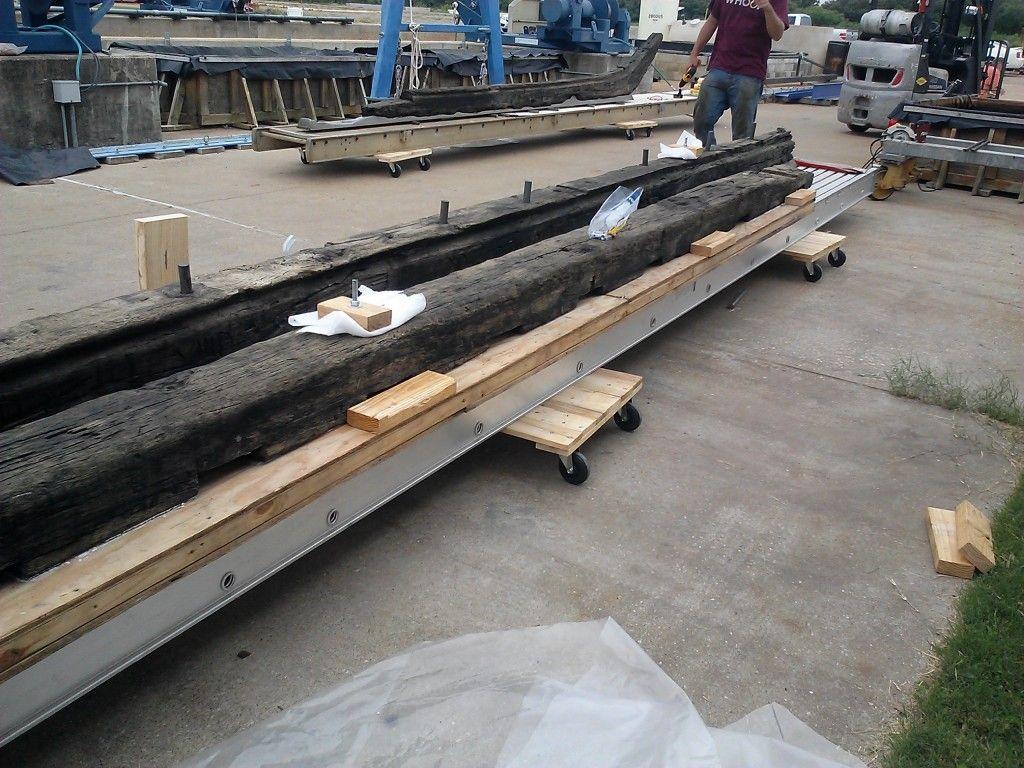The keel and other pieces of wreckage from the 17th century shipwrecked La Belle, were moved successfully Thursday, to the Bullock Texas State History Museum in Austin after a 17-year restoration project by A&M researchers at the Texas A&M Center for Maritime Archaeology and Conservation.
The pieces will be reassembled for an exhibit entitled “La Belle: The Ship That Changed History.”
La Belle arrived beautifully yesterday and we are just very happy about it all,” said Laura Hubbard, marketing director at the Bullock Texas State History Museum. “The museum was in essence built to have this ship, so we are thrilled about seeing all of this come together.”
Jim Jobling, Texas A&M Nautical Archaeology Conservation lab manager, said moving pieces of the La Belle to Austin was a carefully considered process as the wreckage was 300 years old.
The crew Thursday, strapped the pieces to a secure platform base, which prevented the keel and other contents of the ship from destabilizing for the duration of the trip, Jobling said.
Karen Martindale, a graduate student at Texas A&M and a part of La Belle’s conservation and restoration, said freeze drying was used to help preserve the wood and was a fairly inexpensive process.
“If the wood is left untreated, it would warp really badly and would develop cracks or twists horribly, depending on how it was cut,” Martindale said.
Another process used to preserve the wood was submerging the wreckage in a solution called polyethylene glycol, to prevent warping or shrinking, said Donny Hamilton, director of the conservation research lab.
“After Hurricane Katrina essentially the price of petroleum byproducts, like polyethylene glycol, went from 33 cents a pound to almost two dollars a pound,” Hamilton sound. “That increased the cost so much that it would cost 33 million dollars.”
La Belle was intended to be built as a “kit,” said Peter Fix, head project leader for the La Belle restoration project.
The French colonists intended to transport the materials and build the ship in the New World, Hamilton said. However, the ship that the colonists would transport La Belle’s materials on became full. As a result, La Belle was built in France and sailed over to the New World.
La Belle was one of four ships — pioneered by Robert de La Salle, a French explorer — that explored the Gulf of Mexico, Hamilton said.
While looking for the mouth of the Mississippi River, La Salle instead found Matagorda Bay. Hamilton said La Salle fled the ship on foot in hopes to find the Mississippi River. His abandoned crew was then overcome by a storm that ran La Belle aground.
300 years later, at Matagorda Bay Chuck Meide, an underwater archaeologist rediscovered one of the bronze cannons from the La Belle, Hamilton said. From there, the excavation began and was completed in May 1997. The project was then passed on to A&M.
After the excavation was finished, the French Government filed a claim for the ship and its contents, Hamilton said.
“Texas claimed it was theirs and France claimed it was theirs, so the U.S. had to sign a treaty with France acknowledging that the La Belle is still theirs, but [La Belle] is in day-to-day control in Texas,” Hamilton said. “The French Government had to approve all our conservation processes.”
La Belle be on display Oct. 25.
17th century ship wreckage travels from A&M campus to Austin
July 18, 2014
Jim Jobling, A&M Nautical Archaeology Conservation lab manager straps pieces of wood to a platform base.
Donate to The Battalion
Your donation will support the student journalists of Texas A&M University - College Station. Your contribution will allow us to purchase equipment and cover our annual website hosting costs.




















